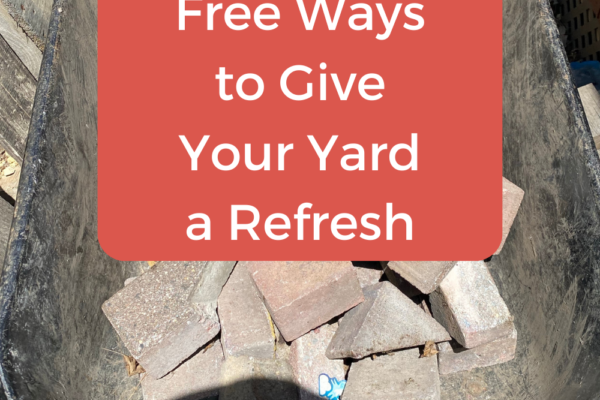Yard projects! Man, we love a good yard project. Maybe too much (if that’s possible). We can’t seem to stop taking them on!
We see a lot of mistakes in yard projects everywhere we go. A lot of yard projects don’t seem like they should be a big endeavor (stacking cinder blocks doesn’t seem that complicated, right?). But there’s a lot more to these projects than meets the eye. If you’ve read any of our other posts, you may or may not know that — not only have we done a lot of yard projects — but we’ve also done them properly and on a budget.
I’m Melissa, and my husband, Ryan, works in engineering. He designs roads and infrastructure for a living. He’s very on top of the rules, regulations, and best practices, which really comes in handy, especially for yard projects.
My role? I’m always willing to help and have learned lots over our years of homeownership. I’m also the one who says, “No,” when it comes to spending. Generally speaking, I demand a pretty tight budget and prefer to work with pre-owned materials, when possible. (Not only is this more budget-friendly, but it’s also more environmentally friendly.)
This is our list of yard project basics.

Why care?
As a homeowner, I know that a haphazardly constructed project is probably going to need to be redone in a few years’ time, so it’s best to do it right the first time. I also know that a project that’s done well can add value to our home and is sure to keep our neighbors happy.
If you’re a renter and are willing to do the project properly, discuss sharing costs with your landlord. If it’s a marketable attribute that they’re able to offer it to future tenants, it could mean additional income for them.
Do the legwork
Before starting on any project, there are a couple of steps you should take.
1) Call Digger’s Hotline – you can find them here.
2) Call you local building inspector – No one likes to finish a project only to be told to take it down and start again. Even if you don’t think you’ll need one, it’s always best practice to check first.
Dig
Almost every yard project out there will require some amount of digging. Whether it’s holes for fence posts, an underground fire pit, or removing sod to lay a brick path. No matter what, the ground underneath your project needs to be level and, if it’s anywhere near your house, graded to keep water away.
SAFETY FIRST! Again, always call Digger’s Hotline before starting a project.
A solid base
You definitely don’t want your project to sink or wash away, so make sure you’ve assessed your soil and created the most appropriate base for your project. Use landscaping fabric, gravel, sand, and a tamper, as necessary. Not sure? Call your local excavator or ask a contractor for guidance on the specifics for your project.
Be level
When Ryan and I first got together, I would laugh and roll my eyes at his need for everything to be so level. But over the years, I’ve really come to appreciate this attention to detail. A level project will last. An unlevel project will slowly undo itself. Think about a brick path that’s started to shift or a tree ring built with retaining blocks that’s starting to lean. You can avoid these problems by ensuring your project is level.
Make sure you have the right one for the job! Use a small one for individual bricks and the long level for your whole surface. And if your surface is near the house…
Consider drainage
If you’re building a patio or gravel pad near your house, make sure that there’s a slight grade away from the house… 2-3%. Keep your level bubble within the middle parameters, but make sure it has the slightest of tilts up toward the house.
Also, make sure you note where water pools in your yard and how it gets out. Be sure not to block these areas. If you do create a barrier with your project, install a catch basin and drain tile. We keep these at the bottom of three of our gutter pipes and run them into a rain garden. (The fourth goes into a rain barrel.)
Learn more about rain garden projects here.
Don’t cut corners
You can cut a lot of corners in life, but don’t do it in yard projects. Sure, it might take a few extra hours or cost another $100, but don’t skip a step or rush the finish. Replace the cracked tile. Adjust the poorly aligned latch. Double check your measurements.
Budget
Of course, not cutting corners doesn’t refer to budget. Budget and final aesthetic should 100% be discussed and weighed when comparing options. We all have a budget to stick with: cedar v. treated pine, tumbled pavers v. concrete tiles, free flagstone from your neighbor v. the pretty slate from your local quarry. If you’re insistent that you rent a mini excavator v. shoveling, be ready to make other concessions. And don’t forget to leave a little wiggle room in the event of a “whoops!”
Know when to hire out
I have absolute faith that you can conquer anything you put your mind to, but know that
THERE. IS. NO. SHAME. IN. HIRING. OUT.
Your time is money, too. If you know a project is going to take up half your summer and that’s not how you want to spend it, hire it out.
If you’re not confident that you can do it or investing in tools is going to cost as much as having someone else do it. Hire it out.
Everyone has limits. Passing a project onto professionals is not only okay, but a smart decision if it doesn’t suit your interest or skill set.
We hope that you find these tips useful! We always love a good project and would love it if you’d share one of your favorite projects or tips in the comments below!
— Ryan & Melissa, The Joneses Four




